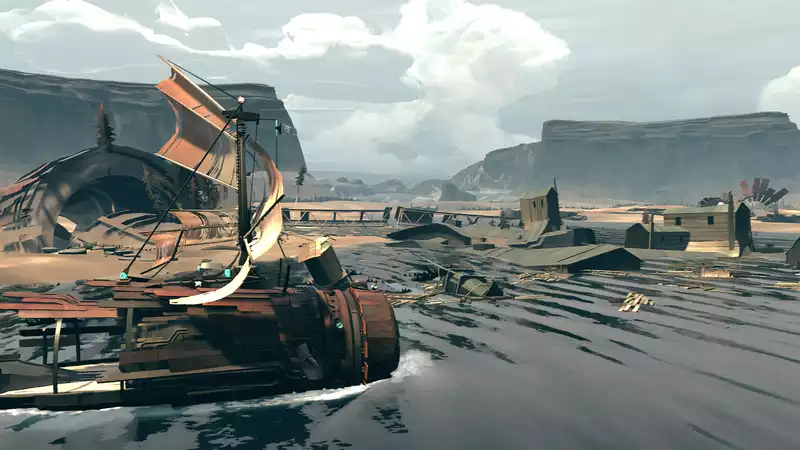Whereas the previous game was about crossing a dried up seabed, Far: There really is so much water here that it looks as if civilization has been swept away by the tide. All that's left is you and the boat you got right at the start of the game. As you come to appreciate the chimerical nature of the boats, several different vehicles, including a steam locomotive, are haphazardly crammed into the game, but "Far" presents a series of new surprises and expands the scope of the side-scrolling world. By the end of the game, I was well acquainted with the nuances of the ship. It's the most rewarding ship in the ocean of video games.
Once you physically jump onto the ship and release it by setting the sails vertically, the only thing you have to worry about is the wind and any natural or man-made obstacles. The latter can usually be cleared by jumping off the ship and solving a (mostly intuitive) mechanical puzzle. The system is simple: drag the sails around in response to the ever-changing winds, but the realistic shifting of the water's surface in response to the changing winds makes you feel like you are really fighting the currents.
Changing Tides stops the puzzle again and again and lets you enjoy the simple pleasure of sailing for a surprisingly long time. The soundtrack fades out and beautiful vistas of sunsets, floating towns, and polar wildlife pass in the background. Keep your eyes on the horizon, gently easing the wind with one hand, and only you and the ocean are there. In between the hectic maneuvers and after the occasional mind-boggling puzzle, these moments of pure sailing await.
Eventually, your boat will be equipped with a loud steam engine. You fill the kamado with this fuel, bounce the bellows to light it, and the mechanical oars push the boat along without the need for wind; a ship management game like FTL or Sea of Thieves, but with one overworked captain taking on every role on the ship.
At times, the back and forth can be stressful. If you run the bellows too hard, the engine overheats and you have to run to the hose to cool the engine, but I don't think you will fail the game, die, or run out of fuel completely. You may be stranded for a few minutes while you search through the scattered junk and painstakingly carry each item to the bottom of the boat, but you always seem to find it when you need it.
Of course, once you get the hang of things, "Changing Tides" will pull the rug from under your feet. The next upgrade to the steam engine turns the ship into a submarine, allowing it to dive under islands, icebergs, and other behemoths and continue its relentless journey right up to the screen.
While not a major change mechanically, the boat now has to make time to move up and down to pass through underwater caves and facilities. While it is true that you can't make mistakes, such as damaging your boat with rocks, it is a challenge to flip the boat or regain momentum when you hit an obstacle and lose speed In Far: Changing Tides, the cost of mistakes generally comes at the cost of such frustration The price for a mistake is generally such frustration.
However, it is not a very serious game. The ship may have many roles, but the important switches are placed close together. And all the manual controls forge a close connection between you and the rusty hunk of metal and wood that makes the open sailing moment feel so meaningful.
Often you have to dive deep into the ocean for supplies, jump onto huge structures to pull switches, push boxes, and do other inexplicable things. It is here that Changing Tides transforms into a more orthodox puzzle platformer, and the game is somewhat less interesting. The puzzles are just the right level of difficulty, neither so hard that you'll be stuck on them for days, nor so easy that you'll feel like you're wasting your time, but the minimalist approach makes it difficult to identify the goal.
There is no text in the game (other than a very early tutorial message) and no gentle nudging in the right direction if you get stuck. While I appreciate the lack of hand-holding, it is sometimes difficult to decipher exactly what Changing Tides is looking for. Is this giant tube a battery? The ones that can be used or moved are kindly painted blue, so you can usually get there by trial and error, but many of the puzzles make sense only with hindsight.
But while the puzzles are nothing special, they clearly serve the purpose they were put there for well: to give you a chance to stretch your legs while interrupting the action. When we finally got back to the boat, I was eager to start the engine and move the boat forward.
You've been in this a long time, by the way. Every time I think I'm nearing the end, "Changing Tides" throws surprise after surprise at me. Like the moment when I first jumped underwater, or when I pulled an entire city out of the deep sea. One moment toward the end of the game, I stared open-mouthed. Only after the ending do I understand why I am doing this and why I am on this journey. And it feels more like a journey than many games with a larger world and more freedom to explore.
It all comes back to that empty moment of sailing the open sea. You, your ship, the beautiful scenery, and the shifting winds. It's the emptiness that makes this peaceful post-apocalypse feel much bigger than it really is.
.

Comments